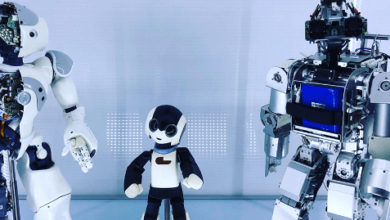Interview with the head of Intel Labs, Dr. Richard Uhlig, on Intel’s moonshot ideas involving integrated photonics, neuromorphic and quantum computing, and more (Dr. Ian Cutress/AnandTech)

Dr. Richard Uhlig of Intel Labs discusses some of Intel’s moonshot ideas, including his recent research into integrating photonic circuits and quantum computers and other projects at Intel Labs. Dr. Richard Uhlig is the director of Intel Labs, where he oversees the efforts of a staff of scientists and engineers to pioneer the next generation of semiconductors. Intel Labs is responsible for creating new, groundbreaking technologies—like Intel’s FPGAs, the world’s first commercially available programmable system-on-a-chip (SoC) and the first commercial neuromorphic chip. Dr. Uhlig gives an insightful look into some of Intel’s major R&D initiatives designed to shape the future of computing and technology. This interview will provide an interesting look into what Intel’s doing to change the computing and communications landscape.
Who is the head of Intel Labs, Dr. Richard Uhlig?
Uhlig is the director of the Laboratory for Information Technology Research (LITR), Intel’s internal research lab in Hillsboro, Oregon. Uhlig began working with Intel in 1988. In 2000 he became a professor in the School of Computer Science at the University of Colorado Boulder. Uhlig has been with Intel for 30 years. He received his doctorate in computer science in 1986 from the University of Illinois. Intel Labs (the research group) is based in Berkeley, California. Dr. Richard Uhlig is the head of Intel Labs and is one of the world’s leading experts on human-computer interaction. Uhlig has worked with numerous companies around the globe, including Hewlett-Packard, Apple, and IBM.
What is Interview with the head of Intel Labs, Dr. Richard Uhlig, on Intel’s moonshot ideas?
The head of Intel’s advanced research lab, Dr. Richard Uhlig, tells us about their moonshots. Uhlig oversees research into semiconductors, computer architectures, and software. He is a professor at the University of California, Berkeley, where he also directs the Berkeley Circuits Research Laboratory. Uhlig is one of Intel’s most highly respected researchers, and his insights into the future of computing are unparalleled. Uhlig shares Intel’s vision of the near future, where computers can operate with the speed and power of the human brain, be used for sensing and decision-making, and merge seamlessly with humans and the real world around them.
What are Intel’s moonshot ideas?
Moonshot projects allow Intel to take big bets on long-term trends. For instance, Intel Labs invented an operating system called Merrifield that runs on its Atom microprocessors. The company wants to build a new chip architecture that takes power and efficiency of current silicon-based chips and then applies those improvements to the next generation. In short, it’s Intel’s saying that it’s moving on from the existing model and building something new.
Conclusion
In conclusion, as we all know, the internet will change everything. Intel is already looking into ways to make the internet of things a reality. The Intel Labs are already developing chips based on integrated photonic components. Dr. Uhlig is optimistic about what the internet of things can do and how it will impact society. He believes that the technology developed in Intel Labs will usher in a new era of innovation. The internet of things, he says, “will change not only the way we live but also the way we think and act.” What do you think?
FAQs
1. What is the Intel Labs team up to?
The Intel Labs team is developing revolutionary technology for Intel that will transform how we think about computing. Our first major announcement is a new technology called “integrated photonics,” which allows light to be used as a computing medium.
2. What does the name mean?
Integrated photonics is a combination of optical and electronic devices. Light is used as the signal in the computer, and the devices are integrated into one package.
3. What is the future of computing?
The end of computing will be based on integrated photonics. It’s the next step in computing.
4. What is the difference between IoT and AI?
IoT is the idea that computers will be embedded in the environment. AI is the idea that computers will learn and adapt to their environment.





